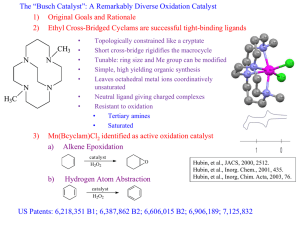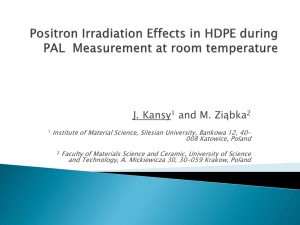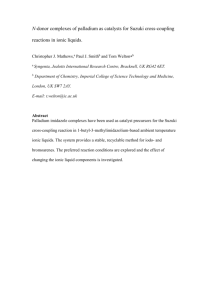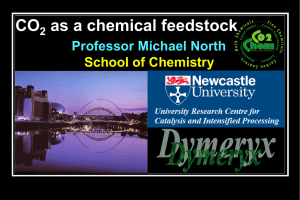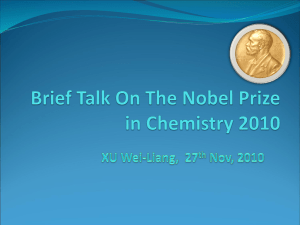Novel palladium imidazole catalysts for Suzuki cross coupling
advertisement
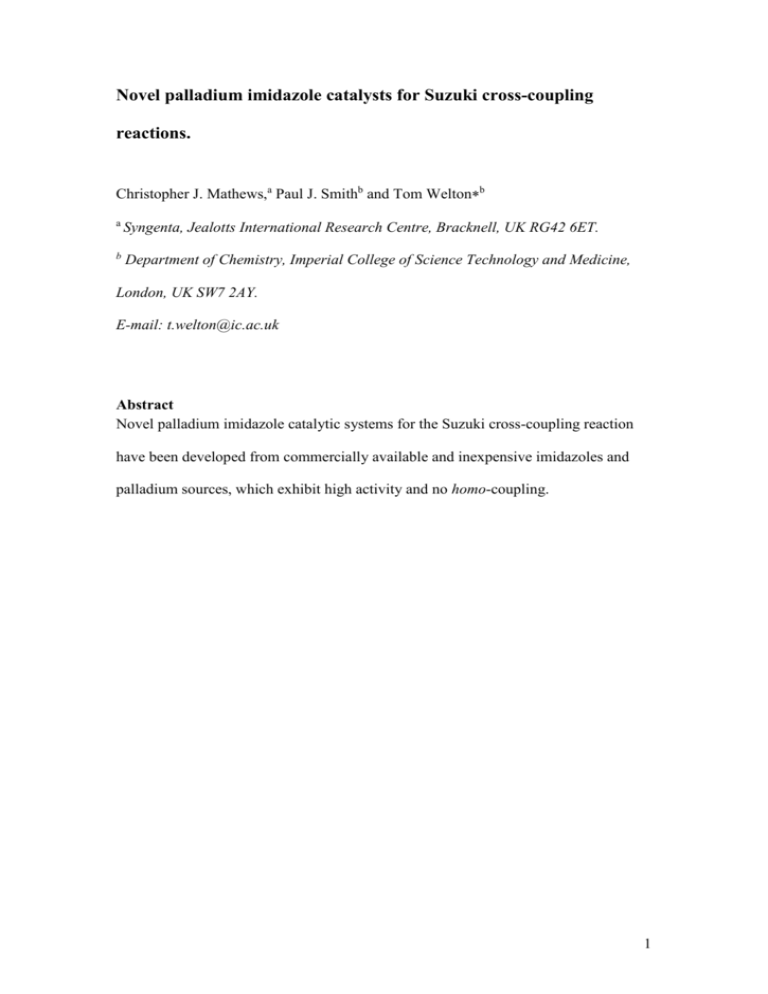
Novel palladium imidazole catalysts for Suzuki cross-coupling
reactions.
Christopher J. Mathews,a Paul J. Smithb and Tom Weltonb
a
Syngenta, Jealotts International Research Centre, Bracknell, UK RG42 6ET.
b
Department of Chemistry, Imperial College of Science Technology and Medicine,
London, UK SW7 2AY.
E-mail: t.welton@ic.ac.uk
Abstract
Novel palladium imidazole catalytic systems for the Suzuki cross-coupling reaction
have been developed from commercially available and inexpensive imidazoles and
palladium sources, which exhibit high activity and no homo-coupling.
1
In recent years there has been a renaissance in palladium catalysed coupling reactions.
This, in part, has been due to the development of highly active and efficient catalytic
systems that have enabled activation of aryl chlorides,1 room temperature catalysis2
and previously inhibited coupling reactions.3 Significant innovations have been made
in the discoveries of novel phosphine systems and in the modification of traditional
phosphines. The replacement of the commonly used triarylphosphine ligands with
sterically-hindered and electron-rich trialkylphosphines,4 phosphites,5 and phosphapalladacycles6 have all given rise to highly active systems in palladium catalysed
coupling reactions.
There are, however, a number of problems that are frequently encountered in
the application of phosphine ligands in catalysis. For example, the degradation of P−C
bonds is notorious and can result in deactivation of the catalyst as well as the
scrambling of the coupling partners with the phosphine substituents.7 This, in addition
to their sensitivity to moisture and aerial oxidation, their often laborious synthesis and
loss during product extraction, has driven research into alternatives to phosphines.
One area where little has been reported to date is the application of N-coordinated
ligands in palladium catalysed coupling reactions. Of those reported most involve
cyclometallated palladium complexes incorporating either the imine,8,9 amine,10 or
oxazoline11 moieties. The remainder include either chelating bi- or terdentate Ncoordinating ligands such as diazabutanes12,13 or bis(oxazolinyl)pyrrole14 ligands,
respectively.
A series of methyl palladium(II) complexes have been reported, incorporating
N-coordinated bis- and tris-imidazole chelates that were found to be catalytically
active in the Heck reaction of 4-bromoacetophenone with n-butyl acrylate.15 More
recently, an example of a mixed imidazolylidene-imidazole palladium complex and
its application in Sonogashira coupling reaction has been reported.16
Although the Suzuki cross-coupling reaction (Scheme 1) is one of the most
powerful methodologies for the generation of new carbon-carbon bonds, particularly
in the synthesis of biaryls, it suffers from a number of disadvantages that limit its
application.17 The traditional triarylphosphine catalysts employed in the Suzuki
reaction often suffer from low activities, poor catalyst solubility and catalyst
decomposition. Further to this, the ubiquitous presence of homo-coupled by-products
that originate from either the halogenoarene or the arylboronic acid coupling with
itself, necessitates additional purification steps. We chose to investigate the use of
2
simple, commercially available imidazoles as ligands for palladium catalysts for
Suzuki cross-coupling reactions.
1.2 mol % (CH3CN)2PdCl2
4.8 mol % alkylimidazole
Br
+
R
(HO)2B
1.1 equiv.
Solvent
2 equiv. Na2CO3 (aq)
R
Scheme 1. The Suzuki coupling reaction of a halogenoarene with tolylboronic acid
The catalysts were prepared in situ from (CH3CN)2PdCl2 (1.2 mol%) and the
appropriate imidazole (4.8 mol%) in the solvent used. After heating to give a solution,
an aqueous sodium carbonate solution, the halogenoarene and tolylboronic acid were
added and the reaction heated to 110 ˚C for 20 mins. The products were isolated by
the addition of water and subsequent extraction with hexane.
The reaction of bromobenzene with tolylboronic acid was investigated in the
first instance. This reaction has the advantage that the product of the competitive
homo-coupling reaction (4,4'-dimethylbiphenyl) can be readily identified in the
product mixture. Initial investigation of the reaction conditions (Table 1) using
(CH3CN)2PdCl2 and 1-methylimidazole as the ligand and dioxane as the solvent
showed that the reaction could be conducted at a wide range of temperatures. At 80
C it afforded a modest yield of 45%, which increased to 98.3% after 3 h. A similar
yield (95.7 %, TON h−1 = 239) could be achieved within 20 min. at 110 C. This
compares very favourably to other N-donor ligands that have been used. For instance,
under similar conditions, but with a higher concentration of catalyst, a series of
diazabutadienes gave yields of between 60 and 99% (TON h−1 between 60 and 99) for
the closely related reaction of 4-bromotoluene and phenylboronic acid.12
The (CH3CN)2PdCl2/4mim {where mim = 1-methylimidazole} catalysed
Suzuki reaction could also be performed at room temperature, affording a 70.2% yield
in 24 h. Although slower than the reaction at higher temperatures, this can be useful
for thermally sensitive substrates. For the subsequent investigations in this project, we
chose to perform the reactions at 110 C for 20 mins.18
3
Table 1 Investigation of Suzuki reaction conditions in dioxane
Entry
Time
Temperature / C
Yield / %a
TON h−1 b
1
2
3
4
20 min
20 min
3h
24 h
110
80
80
25
95.7 (94.2)
45.0 (47.2)
98.3 (96.7)
70.2 (73.9)
239 (236)
113 (118)
27 (27)
2 (3)
Results of repeat reactions in parentheses. a Isolated yield of 4-methylbiphenyl, based on
bromobenzene. Purity confirmed by GC-MS and 1H NMR. b TON h−1 = number of moles of desired
product per mole of catalyst used per hour.
Having established the reaction conditions, we investigated the effect of
changing the imidazole ligands on the reaction in dioxane (Table 2). For comparison,
the use of ‘ligand-free’ palladium sources, the traditional phosphine based catalyst
Pd(PPh3)4, and the independently prepared chlorotris(1-methylimidazole)palladium
chloride {[(mim)3PdCl]Cl}19, have been included.
Imidazoles with an N−H bond did not afford any coupled products and
unreacted bromobenzene was detected at the end of the reaction period (Table 2,
entries 3 and 5). All other imidazoles tested showed considerably greater reactivities
than either the ‘ligand-free’ systems or the traditional Pd(PPh3)4 catalyst under similar
reaction conditions. Little difference was seen in the reactivity of the various multiply
methyl substituted imidazoles and 1-methylimidazole itself. (Table 2, entries 2, 4 and
5). However, a much reduced activity was observed for the 1-phenylimidazole (Table
2, entry 6), so N-substitution can greatly effect the efficacy of the catalyst. We are
continuing to investigate this. Although homo-coupling was clearly seen for the
‘ligand free’ and Pd(PPh3)4 catalyst systems, it was not found in any of the reactions
using imidazole ligands.
4
Table 2 Effect of changing imidazoles in dioxane
Entry
Catalyst/ligand
1
2
(CH3CN)2PdCl2/imidazole
(CH3CN)2PdCl2/1-methylimidazole
3
4
6
(CH3CN)2PdCl2/2-methylimidazole
(CH3CN)2PdCl2/1,2dimethylimidazole
(CH3CN)2PdCl2/1,2,4,5tetramethylimidazole
(CH3CN)2PdCl2/1-phenylimidazole
7
(CH3CN)2PdCl2/none
8
9
PdCl2/none
PdCl2/1-methylimidazole
10
[(mim)3PdCl]Cl
11
Pd(PPh3)4
5
Yield
/%a
0 (0)
95.7
(93.7)
0 (0)
95.5
(96.7)
95.9
(94.4)
63.5
(59.0)
43.2
(45.1)
54.9
94.0
(97.3)
96.5
(95.8)
28.6
TON h−1 b
239 (234)
Homo
/%c
0 (0)
0 (0)
239 (242)
0 (0)
0 (0)
240 (236)
0 (0)
159 (128)
0 (0)
108 (113)
1.9 (2.8)
137
235 (243)
3.5
0 (0)
241 (240)
0 (0)
29
5.23
Results of repeat reactions in parentheses. Extensive catalyst decomposition observed during reaction,
except those which did not afford any product. a Isolated yields of 4-methylbiphenyl, based on
bromobenzene. Purity confirmed by GC-MS and 1H NMR. b TON h−1 = number of moles of desired
product per mole of catalyst used per hour. c Homo-coupled product, 4,4'-dimethylbiphenyl, yield.
The [(mim)3PdCl]Cl shows very similar reactivity to the in situ generated
catalyst (Table 2, entries 2 and 10), suggesting that such palladium imidazole
complexes are, at least, the immediate catalyst precursor.
The
(CH3CN)2PdCl2/4mim
catalysed
Suzuki
reactions
of
different
halogenoarenes were also studied in dioxane (Table 3). The results exhibit no
appreciable difference in yields between the activated and deactivated bromo- and
iodoarenes, all affording around a 95% yield. This indicates the high activity of this
system. However, only the electron-deficient, activated 4-chloroacetophenone crosscoupled to any appreciable extent, affording a 56.2% yield. Addition of the
chlorobenzene also resulted in instantaneous catalyst decomposition of the
(CH3CN)2PdCl2/4mim dioxane solution. Extensive catalyst decomposition was also
observed at the end of each reaction. Whereas no unreacted substrate was detected for
the bromo- and iodoarenes, in all cases unreacted chloroarene was found. No homocoupling was observed in any reaction.
5
Table 3. Scope of the Suzuki reaction with different halogenoarenes in dioxane
Entry
1
2
3
X
I
Br
Cl
R
H
H
H
Yield /%a
95.5
93.7 (96.3)
4.9 (6.4)
TON h−1 b
239
234 (241)
12 (16)
4
5
6
Br
Br
Br
COCH3
CH3
OCH3
96.2
95.9
94.6
241
240
237
7
8
Cl
Cl
COCH3
OCH3
56.2 (54.7)
0
140 (137)
-
Repeat reactions in parentheses. Extensive catalyst decomposition observed during reaction. a Isolated
yield of 4-methylbiphenyl, based on bromobenzene. Purity confirmed by GC-MS and 1H NMR. b TON
h−1 = number of moles of desired product per mole of catalyst used per hour.
The reaction can also be performed in toluene with a slight reduction in yield.
In THF a considerably lower yield was afforded. This is in a large part due to the
lower reflux temperature for THF (65 ˚C) leading to a lower rate of reaction (c.f.
Table 1). Extensive catalytic decomposition was observed in all the reactions. No
homo-coupling was observed in any case.
Table 4. Investigation of Suzuki reaction solvent
Entry
1
2
3
4c
Temperature, / C
110
110
65
100
Solvent
dioxane
toluene
THF
Water
Yield /%a
95.7 (94.2)
89.8 (92.3)
36.8 (38.0)
92.8 (94.1)
TON h−1 b
239 (236)
225 (231)
92 (95)
232 (235)
Repeat reactions in parentheses. Extensive catalyst decomposition observed during reaction. a Isolated
yield of 4-methylbiphenyl, based on bromobenzene. Purity confirmed by GC-MS and 1H NMR. b TON
h−1 = number of moles of desired product per mole of catalyst used per hour. c Palladium added as
[(mim)3PdCl]Cl with no additional 1-methylimidazole.
Aqueous Suzuki reactions were also possible by utilising the excellent water
solubility of [(mim)3PdCl]Cl, which afforded a 92.8% yield in 20 min. In addition to
efficient catalyst-product separations, which are particularly important for large-scale
industrial processes, aqueous reaction media offer a number of economical and
environmental benefits.20 Recently, there has been extensive research into aqueous
palladium catalysed Suzuki reactions.21 These systems commonly employ charged,
water soluble, phosphine ligands, such as sulfonated aryl phosphines or quaternary
ammonium salt derivatives of alkylphosphines. In some cases neutral, water soluble,
6
phosphines have been prepared with glycosides or polymer ethylene glycol supports.
While all of these phosphines supply water soluble catalysts, the need to prepare
specialist ligands adds greatly to the difficulty and expense of the process, whereas
there are many commercially available imidazoles. The preliminary result of the
aqueous mediated Suzuki reaction with the water soluble, phosphine free,
[(mim)3PdCl]Cl, therefore, represents an exciting new area for aqueous Suzuki
catalysis. We are continuing to explore this.
One of the primary drawbacks of the Suzuki reaction in synthesis is the
production of a homo-coupled by-product that can be difficult to separate from the
primary reaction product (Table 2, entries 7, 8 and 11). It is, therefore, of great
interest that no homo-coupling was observed with any of the imidazole-based
catalysts, under any of the reaction conditions used. This suggests that the catalysts
formed in this system do not catalyse the homo-coupling reaction. This is an
important advantage of this system.
In summary, the novel palladium/imidazole catalysed Suzuki reactions were
found to be highly active in dioxane, toluene and water, affording near quantative
yields for bromo- and iodoarenes irrespective of their functionality. Similarly high
yields were afforded at 25 C for 24 hours. A good yield was achieved for the
activated 4-chloroacetophenone, although no significant amount of coupling was
observed for chlorobenzene. The catalytic systems were readily prepared in situ from
commercially available, inexpensive and air stable imidazoles and palladium sources,
circumventing the synthesis of intricate ligands and/or palladium complexes. No
homo-coupled products were obtained from these reactions and the cross-coupled
product could be isolated without any further purification.
Extensive catalyst
decomposition was, however, observed in every reaction and this problem needs to be
addressed. This preliminary investigation highlights the exciting development of
novel palladium/imidazole catalytic systems, with potential applications in room
temperature and aqueous mediated Suzuki reactions. Further investigations to extend
the scope of these catalytic systems are currently in progress.
References
1
a) X. Bei, T. Crevier, A. S. Guram, B. Jandeleit, T. S. Powers, H. W. Turner, T. Uno and W. H.
Weinberg, Tetrahedron Lett., 1999, 40, 3855−3858; b) A. C. Hillier, G. A.. Grasa, M. S. Viciu, H. M.
7
Lee, C. Yang and S. P. Nolan, J. Organometallic Chemistry, 2002, 653, 69−82 c) C. Zhang and M. L.
Trudell, Tetrahedron Lett., 2000, 41, 595−598.
2
a) J. P. Wolfe and S. L. Buchwald, Angew. Chem. Int. Ed., 1999, 38, 2413−2416; b) D. Zim, A. A.
Gruber, G. Ebeling, J. Dupont and A. L. Monteiro, Org. Lett., 2002, 3, 3049−3051; c) A. F. Littke and
G. C. Fu, J. Am. Chem. Soc., 2001, 123, 6989−7000.
3
a) R. Stürmer, Angew. Chem. Int. Ed.¸1999, 38, 3307−3308; b) M. R. Netherton, C. Dai, K.
Neuschütz and G. C. Fu, J. Am. Chem. Soc., 2001, 123, 10099−10100; c) M. Kawatsura and J. F.
Hartwig, J. Am. Chem. Soc., 1999, 121, 1473−1478.
4
a) A. F. Littke, C. Dai and G. C. Fu, J. Am. Chem. Soc., 2000, 122, 4020−4028; b) A. F. Littke and G.
C. Fu, J. Org. Chem., 1999, 64, 10−11; c) J. P. Wolfe, R. A. Singer, B. H. Yang and S. L. Buchwald, J.
Am. Chem. Soc., 1999, 121, 9550−9561; d) A. Ehrentraut, A. Zapf and M. Beller, Synlett, 2000, 11,
1580−1592
5
A. Zapf and M. Beller, Chem. Eur. J., 2000, 6, 1830−1833.
6
For a review see: W. A. Herrmann, V. P. W. Böhm and C. Reisinger, J. Organometallic Chemistry,
1999, 576, 23−41. a) A.Zapf and M. Beller, Chem. Eur. J., 2001, 7, 2908−2915
7
a) D. O’Keefe, M. Dannock and S. Marcuccio, Tetrahedron Lett., 1992, 33, 6679−6680; b) K. C.
Kong and C. H. Cheng, J. Am. Chem. Soc., 1991, 113, 6313−6315.
8
a) M. Ohff, A. Ohff and D. Milstein, Chem. Commun., 1999, 357−358; b) H. Weissman and David
Milstein, Chem. Commun., 1999, 1901−1902.
9
a) D. A. Alonso, C. Nájera and M. C. Pacheco, Org. Lett., 2000, 2, 1823−1826; b) S. Iyer and C.
Ramesh, Tetrahedron. Lett., 2000, 41, 8981−8984; c) S. Iyer and A. Jayanthi, Tetrahedron. Lett.,
2001, 42, 7877−7878; d) D. A. Alonso, C. Nájera and M. C. Pacheco, J. Org. Chem., 2002, 67
5588−5594.
10
F. Yang, Y. Zhang, R. Zheng, J. Tang and M. He, J. Organ met. Chem., 2002, 651,146 −148.
11
B. Tao and D. W. Boykin, Tet. Lett., 2002, 43, 4955−4957.
12
G. A. Grasa, A. C. Hillier and S. P. Nolan, Org. Lett., 2001, 3, 1077−1080.
13
A. S. Abu-Surrah, M. Kettunen, K. Lappalainen, U. Piironen, M. Klinga and M. Leskelä,
Polyhedron, 2002, 21, 27−31.
14
C. Mazet and L. H. Gade, Organometallics., 2001, 20, 4144−4146.
15
a) M. C. Done, T. Rüther, K. J. Cavell, M. Kilner, E. J. Peacock, N. Brauusaud, B. W. Skelton and
A. White, J. Organomet. Chem., 2000, 607, 78−92; b) M. C. Done, T. Rüther, K. J. Cavell, E. J.
Peacock, B. W. Skelton and A. White, Organometallics, 2001, 20, 5522−5531.
16
R. A. Batey, M. Shen and A. J. Lough, Org. Lett., 2002, 4, 1411−1414.
17
a) N. Miyaura and A. Suzuki, Chem. Rev., 1995, 95, 2457−2483; b) J. Hassan, M. Sévignon, C.
Gozzi, E. Schulz and M. Lemaire, Chem. Rev., 2002, 102, 1359−1469; c) D. Prim, J. –M. Campagne,
D. Joseph and B. Andrioletti, Tetrahedron, 2002, 58, 2041−2075; d) N. Miyaura in, Advances in
Metal-Organic Chemistry, ed. L. S. Liebeskind, JAI, London, 1998, vol. 6, pp.87−243; e) A. Suzuki in,
Metal-Catalysed Cross-Coupling Reactions, ed. F. Diederich and P. J. Strang, Wiley-VCH, New York,
1998, Chapter 2.
18
In a typical (CH3CN)2PdCl2/4mim catalysed Suzuki reaction in dioxane a flask was injected with
(CH3CN)2PdCl2 (2.36 mg (0.590 cm3, 15.43 mM), 1.2 mol%) and 1-methylimidazole (3.00 mg,
(0.02050 cm3, 1.784 M), 4.8 mol%) under N2 from CH3CN standard solutions. The CH3CN was
removed in vacuo for 0.5 h without heating affording an off-white solid. The dioxane was injected and
the mixture heated at 110 C for 1h with stirring, cooled to room temperature and then stirred for a
further 10 min. Na2CO3 (161.2 mg, 1.52 mmol, 2 eq.) in deoxygenated water (0.80 ml), bromobenzene
(119.3 mg (0.0800 cm3), 0.760 mmol, 1 eq.) and the tolyl boronic acid (113.8 mg, 0.837 mmol, 1.1 eq.)
were added to the yellow solution, which was then heated at 110 C for 20 min. On completion of the
reaction, the mixture was rapidly quenched in an acetone-solid CO2 bath, diluted with water (2 ml) and
extracted with hexane (4 15 cm3). The completely colourless extractions were washed with brine and
water, filtered through a pad of silica and evaporated to dryness to afford 4-methylbiphenyl (127.6 mg,
95.7%) as a completely colourless crystalline solid.
19
A mixture of PdCl2 (558 mg, 3.15 mmol, 1 eq.) and 1-methylimidazole (2.58 g (2.51 cm3), 31.4
mmol, 10 eq.) was heated at reflux in CH3CN (50 cm3) with vigorous stirring for 6 h under N 2. The
pale yellow solution was slowly reduced in vacuo to dryness, washed with ethanol and ether, then dried
to give [(mim)3PdCl]Cl (971 mg, 72.9%) as an off-white powdery solid; mp 214−215 C (decomp);
max / cm−1 (KBr) 3104 and 3054 (CH aromatic), 2922, 2867 and 2780 (CH aliphatic), 1543, 1526,
1121, 837, 764, 660 and 623; H(270 MHz, CDCl3) / ppm 7.70 (s, N2CH, 1H), 7.17 and 6.85 (d, NCH,
8
2H), and 3.76 (s, NCH3, 3H); C(270 MHz, D2O) / ppm 139.3 (N2CH, 1C), 128.2 and 122.5 (NCH,
2C), and 34.50 (NCH3, 1C); Acc. Mass (FAB) 389.0306 correct for C 12H18N6Cl1Pd1; m/z (FAB) 389
([(mim)3PdCl]+, 100%), 270 ([(mim)2Pd]+, 50), 188 ([(mim)Pd]+, 10) and 83 ([mimH]+, 22).
20
Aqueous-Phase Organometallic Catalysis, B. Cornils, W. A. Herrmann, Eds.; Wilely-VCH:
Weinheim, 1998.
21
a) J. P. Genet and M. Savignac, J. Organomet. Chem., 1999, 576, 305−317; b) C. Dupuis, K. Adiey,
L. Charruault, V. Michelet, M. Savignac and J. –P. Genêt, Tet. Lett., 2001, 42, 6523−6526; c) M.
Nishimura, M. Ueda and N. Miyaura, Tetrahedron, 2002, 58, 5779−5787; d)Y. Uozumi and Y.Nakai,
Org. Lett., 2002, 4, 2997−3000; e) K. H. Shaughnessy and R. S. Booth, Org. Lett., 2001, 3,
2757−2759; f) E. Paetzold and G.Oehme, J. Mol. Cat., A, 2000, 152, 69−76.
9
